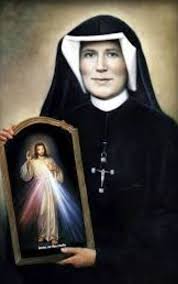
Twenty years ago the canonization of Saint Faustina apostle of Mercy
Through the canonization of Saint Faustina, Pope John Paul II wanted to transmit to the New Millennium the message of Divine Mercy to all men so that they “learn to know better and better the true face of God and the true face of the brothers”.
If so, he had imagined his canonization. Sister Faustina Kowalska had seen and described it in her diaries in 1937, and in this way it happened. On April 30, 2000, St. John Paul II canonized Sister Faustina Kowalska, who had spread the image and cult of Divine Mercy to the world.
If the image, painted in Vilnius, had experienced various vicissitudes, the cult remained steadfast. St. John Paul II was soaked in it. He stopped in Lagiewniki, at the monastery of Sister Faustina, every day going to work in the Solvay factory. And he made Divine Mercy the cornerstone of his priestly life and then that of his pontificate. His first encyclical is titled Dives in Misericordia, riches in mercy. It was he who established the Sunday of Divine Mercy, which is celebrated the first after Easter. It was he who beatified and canonized Sister Faustina.
Sister Faustina recounts her canonization in points 1044 – 1048 of her diary.
“Suddenly – Sister Faustina writes – the presence of God submerged me and I saw myself all of a sudden in Rome, in the chapel of the Holy Father and at the same time it was in our chapel. And the solemn celebration of the Holy Father and of the whole Church was closely connected with our chapel and in particular with our Congregation and I participated simultaneously in the solemnity in Rome and among us “.
In the memoirs of Saint Faustina, the solemnities are so closely united that they cannot be distinguished. “I saw – he says – in our chapel Jesus exposed in the monstrance on the main altar. The chapel was solemnly decorated and on that day all people were allowed to enter, whoever wanted it. The crowd was so large that I could not embrace the whole view. Everyone participated in this solemnity with great joy and many of them got what they wanted. “
The same happened in Rome “in a beautiful temple and the Holy Father with all the clergy celebrated this solemnity. And all of a sudden I saw Saint Peter standing between the altar and the Holy Father. I couldn’t hear what Saint Peter said, but I sensed that the Holy Father understood his language “.
So, Sister Faustina saw the two rays come out of the host as they are painted on the image and spread over the whole world, an episode that happened in a moment, but as if it had lasted all day, and our chapel has been overcrowded all day and all that day was full of so much joy. “
Sister Faustina sees Jesus on the altar, as in the painting she commissioned,
Sister Faustina then says that she was “kidnapped and brought close to Jesus on the altar”, in an “abyss of serenity”. Jesus asked her what she wanted, she replied the glory and the cult for her mercy, and Jesus said that the cult was already there. Then Sister Faustina asked to bless “all those who are gathered together to honor you and your infinite mercy”. Jesus made a sign of the cross on the crowd.
Sister Faustina concludes: “When I returned to myself, a profound peace flooded my soul and my mind was allowed to understand in a strange way many things, which before were incomprehensible to me”.
Sister Faustina’s voice resounds in Poland thanks to actress Halina Labonarska, who since 2000 has read passages from Sister Faustina’s Diary. The first passage was read an hour before the start of the canonization ceremony.
Labonarska recounts: “God is near. Very close. When God himself appeared to Sister Faustina, the emotions that accompanied her in her encounters with Christ were natural. She wrote what she felt, guided by the great adoration of God.She did not know literary models, nor did she have an education that would allow her to describe her experiences in a poetic way. Yet everything he wrote was extraordinary. For me, this simplicity was something very close and real. I have seen greatness in this simplicity ”.
Labonarska added that “Sister Faustina teaches us, as Jesus taught her, to speak to him simply and simply. The saint wants us to treat her like a close friend. And I treat Faustina like this. “Diary” is the most popular mystical work of the twentieth century, alongside the work of Saint John Paul II, translated into many languages - that’s why I recommend it to everyone I meet, that’s why I decided to publish the ‘Diary’ in the its entirety“.
During that celebration, John Paul II completed a pontificate program. “From divine Providence – said St. John Paul II – the life of this humble daughter of Poland has been completely linked to the history of the twentieth century, the century that we have just left behind. It is, in fact, between the first and second world wars that Christ entrusted her with his message of mercy. Those who remember, who witnessed and participated in the events of those years and the horrible suffering that ensued for millions of men, know well how much the message of mercy was necessary “.
The Polish Pope was already looking to the future. It is not known, he said, how the years will come, but “it is certain that alongside new progress, unfortunately, there will be painful experiences”. Yet, “the light of divine mercy, which the Lord almost wanted to return to the world through the charism of Sister Faustina, will illuminate the path of men in the third millennium”.
And it was through that canonization that St. John Paul II wanted to transmit the message of Divine Mercy to all men to the New Millennium, so that they “learn to know better the true face of God and the true face of the brothers”.
In particular, the Polish Pope remembered a passage from Sister Faustina’s Diary, in which she wrote that she felt “tremendous pain when I observe the sufferings of others. All the pains of our neighbor affect my heart; I carry their anxieties in my heart, so that they also annihilate me physically. I would like all the pains to fall on me, to bring relief to the neighbour “
And this is, stressed John Paul II, the love on which humanity “must be inspired to face the crisis of meaning, the challenges of the most diverse needs, especially the need to safeguard the dignity of each human person. The message of divine mercy is thus implicitly also a message on the value of every man. Each person is precious in the eyes of God, for each Christ has given his life, to all the Father makes a gift of his Spirit and offers access to his intimacy “.
A message, continued Saint John Paul II, addressed above all to those who “afflicted by a particularly hard trial or crushed by the weight of the sins committed, have lost all trust in life and are tempted to give in to despair. The sweet face of Christ is presented to him, those rays come from him which start from his heart and illuminate, warm, indicate the path and instill hope ”.
 It is the invitation to entrust oneself to Jesus, as written in the painting.
It is the invitation to entrust oneself to Jesus, as written in the painting.
Jezu Ufam Tobie, Jesus I trust in you.
That invitation that Sister Faustina resounded all over the world, and that John Paul II reiterated with his canonization, 20 years ago.
